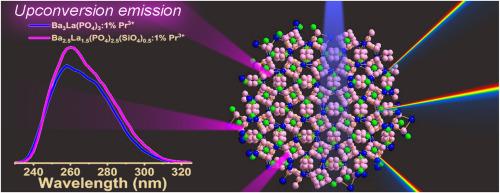Pr3+掺杂乙长石型磷酸盐的UVC上转换发光增强
IF 3.6
3区 物理与天体物理
Q2 OPTICS
引用次数: 0
摘要
UVC辐射的强大防腐性能使其成为水和表面净化的理想选择,强调了对新型UVC生成材料的需求。本文采用Pechini法合成了掺杂Pr3+的Ba3La(PO4)3和Ba2.5La1.5(PO4)2.5(SiO4)0.5荧光粉,并对其结构和发光性能进行了研究。两种化合物均以立方欧拉长石型结构结晶,表现出比3P0→3H4 (465 ~ 505 nm)转变更强的1D2→3H4 (575 ~ 645 nm)发射。在紫外激发下,观察到有效的5d-4f发射,而444 nm激光激发通过以激发态吸收(ESA)为主的双光子过程诱导UVC上转换。当Pr3+掺杂量为1.5%时,Ba2.5La1.5(PO4)2.5(SiO4)0.5的上转换强度比Ba3La(PO4)3高30%,这是由于局域无序和晶体场效应的增强。这些材料在上转换发射方面优于YPO4:Pr3+磷酸盐,突出了它们在uvc发射器件中的应用潜力。本文章由计算机程序翻译,如有差异,请以英文原文为准。

Enhanced UVC upconversion luminescence in Pr3+-doped eulytite-type phosphates
UVC radiation's strong antiseptic properties make it ideal for water and surface decontamination, underscoring the need for new UVC-generating materials. In this work, Pr3+-doped Ba3La(PO4)3 and Ba2.5La1.5(PO4)2.5(SiO4)0.5 phosphors were synthesized via the Pechini method, and their structural and luminescent properties were investigated. Both compounds crystallize in a cubic eulytite-type structure and exhibit stronger 1D2 → 3H4 (575–645 nm) emission than the 3P0 → 3H4 (465–505 nm) transition. Under UV excitation, efficient 5d–4f emission is observed, while 444 nm laser excitation induces UVC upconversion via a two-photon process dominated by excited-state absorption (ESA). Optimal upconversion occurs at 1.5 % Pr3+ doping, with Ba2.5La1.5(PO4)2.5(SiO4)0.5 showing ∼30 % higher intensity than Ba3La(PO4)3 due to enhanced local disorder and crystal field effects. These materials outperform YPO4:Pr3+ phosphate in upconversion emission, highlighting their potential for use in UVC-emitting devices.
求助全文
通过发布文献求助,成功后即可免费获取论文全文。
去求助
来源期刊

Journal of Luminescence
物理-光学
CiteScore
6.70
自引率
13.90%
发文量
850
审稿时长
3.8 months
期刊介绍:
The purpose of the Journal of Luminescence is to provide a means of communication between scientists in different disciplines who share a common interest in the electronic excited states of molecular, ionic and covalent systems, whether crystalline, amorphous, or liquid.
We invite original papers and reviews on such subjects as: exciton and polariton dynamics, dynamics of localized excited states, energy and charge transport in ordered and disordered systems, radiative and non-radiative recombination, relaxation processes, vibronic interactions in electronic excited states, photochemistry in condensed systems, excited state resonance, double resonance, spin dynamics, selective excitation spectroscopy, hole burning, coherent processes in excited states, (e.g. coherent optical transients, photon echoes, transient gratings), multiphoton processes, optical bistability, photochromism, and new techniques for the study of excited states. This list is not intended to be exhaustive. Papers in the traditional areas of optical spectroscopy (absorption, MCD, luminescence, Raman scattering) are welcome. Papers on applications (phosphors, scintillators, electro- and cathodo-luminescence, radiography, bioimaging, solar energy, energy conversion, etc.) are also welcome if they present results of scientific, rather than only technological interest. However, papers containing purely theoretical results, not related to phenomena in the excited states, as well as papers using luminescence spectroscopy to perform routine analytical chemistry or biochemistry procedures, are outside the scope of the journal. Some exceptions will be possible at the discretion of the editors.
 求助内容:
求助内容: 应助结果提醒方式:
应助结果提醒方式:


